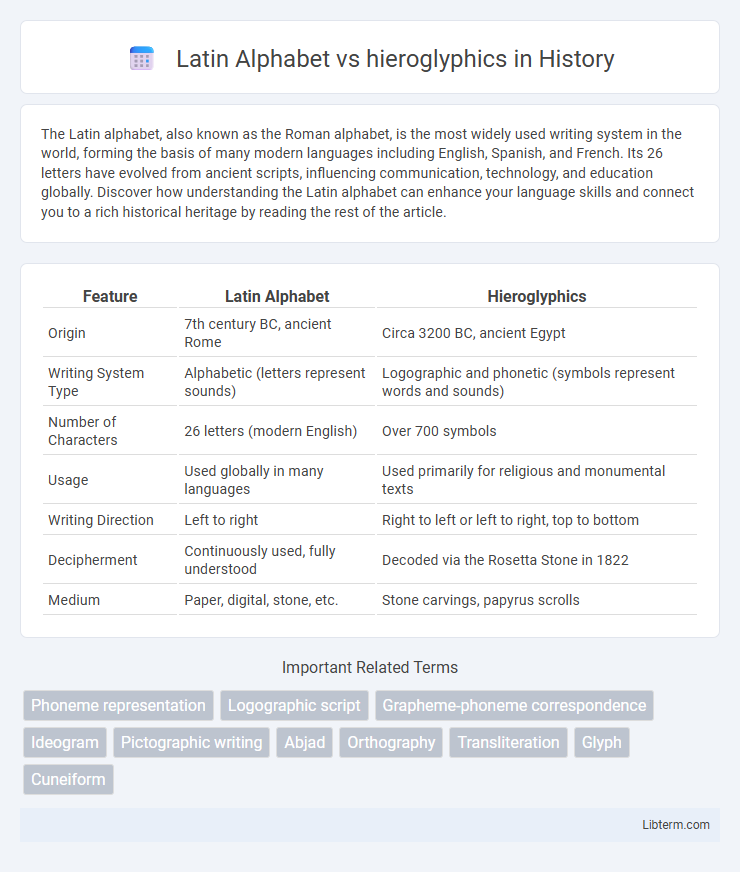The Latin alphabet, also known as the Roman alphabet, is the most widely used writing system in the world, forming the basis of many modern languages including English, Spanish, and French. Its 26 letters have evolved from ancient scripts, influencing communication, technology, and education globally. Discover how understanding the Latin alphabet can enhance your language skills and connect you to a rich historical heritage by reading the rest of the article.
Table of Comparison
| Feature | Latin Alphabet | Hieroglyphics |
|---|---|---|
| Origin | 7th century BC, ancient Rome | Circa 3200 BC, ancient Egypt |
| Writing System Type | Alphabetic (letters represent sounds) | Logographic and phonetic (symbols represent words and sounds) |
| Number of Characters | 26 letters (modern English) | Over 700 symbols |
| Usage | Used globally in many languages | Used primarily for religious and monumental texts |
| Writing Direction | Left to right | Right to left or left to right, top to bottom |
| Decipherment | Continuously used, fully understood | Decoded via the Rosetta Stone in 1822 |
| Medium | Paper, digital, stone, etc. | Stone carvings, papyrus scrolls |
Introduction to Writing Systems
The Latin alphabet, consisting of 26 letters, represents phonetic sounds allowing flexible and efficient written communication widely used in modern languages. Hieroglyphics, an ancient Egyptian writing system, employ symbolic characters that combine logographic and alphabetic elements to convey complex ideas and sounds. These foundational writing systems illustrate the evolution from pictorial symbols to abstract phonetic representation, shaping the development of literacy and communication across cultures.
Origins of the Latin Alphabet
The Latin alphabet originated from the Etruscan adaptation of the Greek alphabet around the 7th century BCE, evolving to suit the phonetic needs of the early Latin language. This alphabet, consisting initially of 21 letters, spread widely throughout the Roman Empire, becoming the foundation for many modern Western writing systems. Unlike hieroglyphics, which are logographic and symbolic, the Latin alphabet is a phonetic system designed for efficiency and adaptability in written communication.
The History of Hieroglyphics
Hieroglyphics originated around 3100 BCE in ancient Egypt as a complex system combining logographic and alphabetic elements, primarily used for religious texts and monumental inscriptions. Unlike the Latin alphabet, which evolved from the Phoenician script and consists of 26 letters representing individual sounds, hieroglyphics included hundreds of distinct symbols representing sounds, objects, and ideas. The decline of hieroglyphics began with the spread of Greek and Latin scripts, culminating in its decipherment in the 19th century through the Rosetta Stone.
Visual Structure and Symbols
The Latin alphabet consists of 26 letters with simple, linear shapes designed for ease of writing and recognition, promoting efficient communication across diverse languages. In contrast, hieroglyphics employ intricate pictorial symbols representing sounds, objects, or ideas, creating a visually complex script closely tied to cultural and religious contexts. The visual structure of hieroglyphics is more elaborate and decorative, often arranged in horizontal or vertical columns, while Latin letters are standardized and primarily linear for rapid reading and writing.
Phonetics vs. Logograms
The Latin alphabet is a phonetic writing system that represents individual sounds or phonemes, enabling efficient encoding of spoken language and facilitating literacy through sound-to-symbol correspondence. Hieroglyphics, in contrast, are primarily logograms combined with phonetic elements, where symbols represent whole words, ideas, or sounds, often requiring contextual interpretation. This distinction highlights the Latin alphabet's streamlined phonetic approach versus hieroglyphics' complex mixture of logographic and phonetic components, influencing readability and learning processes.
Evolution and Adaptation
The Latin alphabet evolved from the Phoenician script through the Greek alphabet, simplifying complex symbol sets into 26 standardized letters suited for diverse European languages, enhancing readability and writing efficiency. Hieroglyphics, originating in ancient Egypt, functioned as a complex system of logograms and phonograms, requiring specialized knowledge for interpretation and evolving into simpler scripts like Demotic for broader administrative use. The adaptability of the Latin alphabet allowed widespread dissemination through printing technology and digital communication, whereas hieroglyphics gradually phased out as alphabetic systems proved more practical for everyday use and record-keeping.
Ease of Learning and Use
The Latin alphabet consists of 26 letters representing individual sounds, making it easier to learn and use due to its limited symbols and phonetic consistency. Hieroglyphics comprise hundreds of intricate symbols representing objects, concepts, and sounds, requiring extensive memorization and contextual understanding. The streamlined structure of the Latin alphabet facilitates faster reading and writing, while hieroglyphics demand specialized knowledge and longer learning periods.
Influence on Modern Languages
The Latin alphabet, originating from ancient Rome, serves as the foundation for most modern Western languages, including English, Spanish, and French, directly influencing global communication and digital encoding systems. Hieroglyphics, an ancient Egyptian script comprising pictorial symbols, primarily impacted linguistic studies and art history rather than contemporary language structures. While the Latin alphabet streamlined phonetic representation, facilitating literacy and language standardization, hieroglyphics remain vital for understanding cultural and religious symbolism in historical contexts.
Cultural Significance
The Latin alphabet, rooted in ancient Rome, revolutionized communication by providing a versatile, phonetic writing system that enabled widespread literacy and cultural exchange across Europe and beyond. Hieroglyphics, used primarily by ancient Egyptians, held profound religious and ceremonial importance, encoding complex ideas through symbolic imagery that connected language with spirituality. The contrast underscores the Latin alphabet's role in democratizing knowledge versus hieroglyphics' function as a sacred script embodying cultural identity and divine connection.
Legacy and Preservation
The Latin alphabet's legacy endures through its widespread adoption in global languages, facilitating seamless communication, literacy, and digital encoding standards like Unicode. In contrast, Egyptian hieroglyphics, preserved primarily through archeological finds and Rosetta Stone decipherment, offer invaluable insights into ancient civilizations but lack modern practical application. Preservation efforts for hieroglyphics focus on cultural heritage and academic study, while the Latin alphabet continuously evolves and supports contemporary written communication worldwide.
Latin Alphabet Infographic

 libterm.com
libterm.com